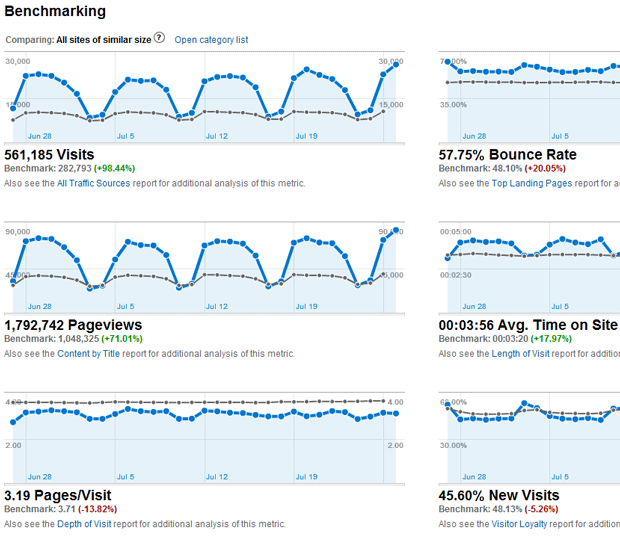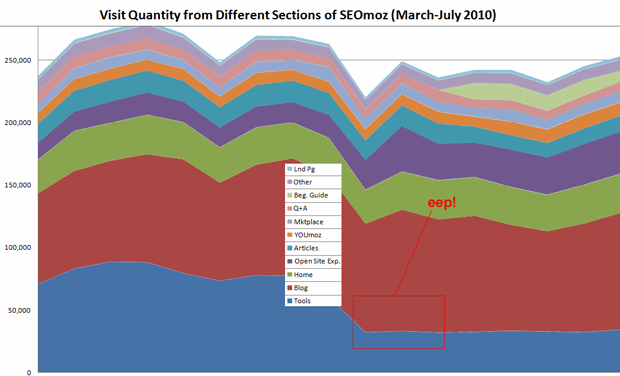
How to Benchmark in Analytics
The author's views are entirely their own (excluding the unlikely event of hypnosis) and may not always reflect the views of Moz.
We have a lot of changes going on at SEOmoz (feel free to get excited, we sure are!) and with all of these changes to the site comes the need to focus on tracking. Internally we have spent the last few months redirecting our attention to not only the best practices regarding analytics and data mining, but really pushing ourselves to revisit our analytical processes.
You know what we realized? There sure is a lot of data. While I have always appreciated the reporting features in GA, I find that too often people take the reports at face value and fail to go deeper. It’s unfortunate since it is in those deep dives that you usually discover the data that can change your current course of action. So this post is going to tackle an approach to analytics that is often overlooked and (thanks to Google and their silly naming convention decisions) is rarely used to its fullest capacity. Get excited folks we are going to talk about benchmarking {Woohoo! Insert audience applause here}.
All of you excel spreadsheet lovers out there know plenty of ways to extract data and pinpoint specific red flags or recent successes. In fact, most people use analytics to simply analyze the current state of their account. While this is certainly a priority, it really is one dimensional. Instead of stopping there, why not go further? Why not better understand where your data was, and how you are measuring up? In fact, why not use this data to help inform your internal decisions as a company? It’s like an analytical epiphany—“using past and current data to help guide you moving forward.” Glorious.
While many of the analytics platforms out there have given us a number of ways to compare historical data to current data, we are still limited to two distinct time ranges (for the most part). It’s great to see those two ranges stack up against each other, but that still leaves a lot to be desired. Without going further you miss the "interaction" between those two distinct time ranges.
Benchmarking your data is a great way to discover more about this, often overlooked, gray area. Benchmarking simply means you set a standard at which you compare something else to. When used for data mining, it means you plot two distinct variables (time ranges, metrics, dimensions, etc.) over a period of time and then use these “benchmarks” to infer conclusions when making decisions.
You can then see a more complete picture of your site’s momentum. In my opinion, understanding your site’s momentum is one of the most powerful metrics an analyst can calculate. If you can say with authority that you know how your site is doing and how it will likely be doing in the next week, month, few months, etc., you are in an ideal place. With data like that you can take more calculated risks.
*First, I want to throw out a disclaimer—a little over a year ago Google decided to integrate “Benchmarking” into their Visitors tab in GA. This just made things confusing in my opinion. The GA feature actually shows your site in comparison to a {very very very limited} industry pool of similarly {not really} sized sites. There is a lot wrong with the assumptions of this feature, but for our purposes here, when I say “benchmarking” I mean the act of plotting two distinct variables over time to extract insight…not the {ridiculous-I-can’t-believe-they-took-it-out-of-beta} GA feature.

The "benchmarking" feature in GA on SEOmoz
Okay now that we got that out of the way, let’s talk about how you can benchmark your data to hopefully gather some insight into your site’s performance.
Know your bottom-line (and your "high-line" –yes, I just made that word up)
This is probably the most common approach to benchmarking. It’s a pretty simple way to analyze the current state of your account. You should know your extremes for every metric. For example if you are a company that sells a seasonally successful product, you should know what your lowest conversion rate is for the year, as well as your peak conversion performance. In understanding the extremes you can make better assumptions on how your off season stats are trending. While not the most accurate approach to data mining, benchmarking the extremes of your account enables you to speak intelligently, at any given moment, on how your site is currently performing.
Know your ratios & relationships
Am I the only one that always reads “ratio” as “radio”? I digress. Knowing your metric ratios and how they relate to each other, is a great way to quickly detect when things are headed south. Often, as analysts, we don’t realize something has gone wrong until we see sales are down. While that is an effective method of pinpointing mistakes, it certainly isn’t ideal. Wouldn’t it be nice to quickly identify issues as they actually become issues? Crazy, I know. Well this is exactly what benchmarking the ratios of your site’s metrics can do. At SEOmoz, we use ratio/relationship benchmarking to keep our traffic stats in check. We don’t just plot out how many visitors each section of the site brings in out of the total visitors; we compare those percentages against each other. This gives us a ballpark value to guide us. An example; “the X part of the site brings in roughly twice as much as Y, which brings in about 1/3 of the traffic as Z.”
The great part about this method of benchmarking is you can easily turn it into a visual representation of the different pieces of the pie, and isolate out when things start to shift. Below is an actual example Rand pulled together earlier this week (yes he does that sort of thing for fun! A true data-head!). In this chart we have graphed out the top trafficked pages on our site, and then plotted them against each other to show how they are performing in relation to each other.

Also see a larger, detailed version
You can see the significant drop in the blue segment (our Tools page), which was due to a redirect mistake we made (oops...Rand talks more about that here). By visually representing these sections, we can easily identify shifts in the relationships, which can guide us on where we should focus our attentions (aka fix our silly SEO mistake ASAP!).
Know the norm
Okay I know, I know…I talked a whole lot of trash above on the GA benchmarking feature, and here I am talking about “knowing the norm,” but approaching data analysis this way can be insightful. Knowing and using industry standards in benchmarking can efficiently identify low hanging fruit.
However, the actual GA benchmarking tab is a poor example of this. Keep in mind that sites have to opt into the benchmarking, so (a.) this feature might not even have your industry represented and (b.) you have no way of knowing how many sites these “standards” are calculated on. Also keep in mind there are only three buckets for website “size” in this feature—small, medium, and large. WTF right? Yeah, since when do all websites fit into those three sizes? What am I ordering a latte over here?
With that said, it’s worth knowing the vital metric standards for your industry. If you see that similar sites to your own have a bounce rate of around 40% and you are chilling around 65%, while all the other metrics look closer in range, then you can assume this metric is where you should direct your optimization efforts. This approach isn’t as scalable or as accurate as other benchmarking methods, but it’s definitely worth a mention, if only for peace of mind.
Know the limits
While benchmarking is incredibly effective for things like trending, projecting, and exploring the data, it’s important to know the limits of the process. It is meant to be a discovery process, not a scientific formula. Just like anything else you take away from the data, it is just an insight, not a guarantee. You are making assumptions based on past performances, and performances change. So one word of caution to all of you data-heads out there—benchmarking is a great tool to add to your bag of tricks, but it is only one of many you should be using. Don’t get so caught up in forming relationships between the metrics and dimensions of your site that you lose perspective on the independent variables themselves.
In conclusion
Get in there. I mean it, seriously. I know we are all crazy busy, but that shouldn’t translate into a two minute GA log-in, a quick glance at the vital metrics and a few automated reports. Our analytics are meant to be explored. Benchmarking is one of those processes that may take an extra hour or two, but discoveries made during those few hours can be instrumental in guiding your company’s decisions.
Confession: At SEOmoz we haven’t always been the best with analytics and tracking, but in the past half a year we have refocused our energies on truly knowing what our users are doing, how our site is performing, and finding opportunities within the data. It’s time consuming, and tricky, and what you discover is not always fun to find out, but it has certainly helped us redirect resources where they are needed.
Over the next few months we are rolling out all sorts of good stuff, {the Chrome toolbar launch was just a teaser my friends  }. We are using processes like benchmarking to better prepare us for these changes. Taking on new challenges as a company is an awesome thing, but doing it with a little data to steer you, makes the ride even more fun.
}. We are using processes like benchmarking to better prepare us for these changes. Taking on new challenges as a company is an awesome thing, but doing it with a little data to steer you, makes the ride even more fun.




Comments
Please keep your comments TAGFEE by following the community etiquette
Comments are closed. Got a burning question? Head to our Q&A section to start a new conversation.